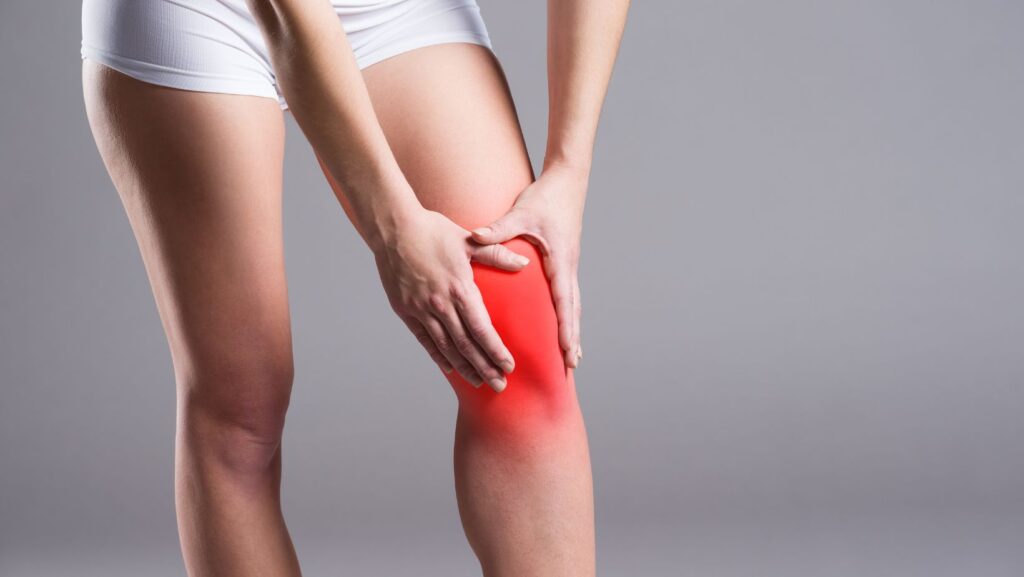
It is easy to blame sleeping in a bad position for waking up stiff or in pain, but when it happens more than once, you may be dealing with chronic joint or muscle problems.
Painful joints or muscles can adversely affect your quality of life, interfering with mobility, physical activities, and daily functions.
How do you know if your pain is coming from your joints or muscles – or could it be both? Are their different treatments based on the type of pain? What are the causes?
These are the questions we examine in this report.
What Is Joint Pain?
Pain can affect any joint, including the fingers, toes, hips, knees, ankles, and neck. The symptoms may vary; some people experience throbbing, while others suffer stabbing, grating, or burning sensations.
While the pain level may vary considerably during the day, many people report feeling the worst in the morning, right after waking. Joint stiffness due to inactivity during sleep can make it difficult to get moving at the start of your day. Other people report feeling worse as the day progresses due to overuse of the joints.
Pain can influence the joint’s ability to move, as you may be unable to complete physical tasks as the bones rub together. That is a feature of osteoarthritis when the cartilage cushioning the joints begins to wear away.
Here are some leading types of joint pain to know:
● Rheumatoid arthritis: This disease causes pain and swelling in the joints, and for some people, the joints in the wrists and fingers become deformed and crooked.
● Osteoarthritis: This condition is often associated with aging due to the erosion of cartilage that causes loss of the cushion between the bones.
● Bursitis: Often seen in athletes, bursitis occurs when a joint is overused. The knees, hips, shoulders, and elbows are most susceptible to this condition.
● Tendinitis: Another overuse area, tendinitis, occurs when the flexible bands (tendons) connecting muscle to bone become inflamed. Tendinitis is most common in the shoulder, elbow, and heel.
● Gout: In this condition, crystals form in the joint, often the big toe, causing swelling and severe pain.
Unlike muscle pain, which can improve with rest, joint pain is often continuous. This is because there are often mitigating factors causing joint pain, including some autoimmune disorders. You can often tell the difference based on where you feel the pain. Joint pain is often felt deeper, while muscle pain may appear closer to the surface.
Rubbing the muscle may help with muscle pain but not joint pain.
What Is Muscle Pain?
Also called myalgia, muscle pain can severely limit your mobility. Painful, stiff muscles can make it hard to move, but with rest, the symptoms often subside, especially when dealing with short-term pain.
However, chronic muscle pain is a different situation that often stems from some health problem. Muscular pain can be centralized around a specific area or radiate throughout the body. Some people report sharp or stabbing pains, while others experience deep or steady pains.
Another type of muscle pain is delayed-onset muscle soreness (DOMS) that results from exercise or overuse. The symptoms of DOMS may not appear until hours after performing the activity, and they can last for up to 48 hours. Overexertion of the muscle results in muscle tears, which is the basis of bodybuilding when trying to increase muscle size. It is crucial to avoid working the same muscle groups two days in a row to allow for the muscle repair necessary for growth.
Causes of Muscle or Joint Pain
Acute muscle and joint pain can affect any part of the body. Reduced range of motion, stiffness, swelling, and aches are common signs of problems. Diagnosis tools depend on the results of the consultation and examination. Lab tests, ultrasounds, x-rays, or other image scans (CT scans and MRIs) may be necessary. Doctors can also use electromyography to measure the electrical activity in the muscles and nerves.
Some of the most common causes of muscle and joint pains include:
● Bad posture
A common cause of muscle or joint pain is bad posture. Sitting or standing for long periods in an unhealthy position can lead to chronic pain.
● Muscle strains
Heavy or improper lifting, carrying heavy loads, or overuse of muscles can lead to muscle pain.
● Intensive sports or work
Physically demanding jobs or activities can strain the muscles and joints, leading to body aches.
● Injuries and Fractures
Sprains, injuries, and broken bones are two leading causes of joint or muscle pain. Also, inactivity due to healing time can cause atrophy and additional pain. Broken bones can cause pain in the bones and the muscles surrounding the injured area.
● Dislocation of joints
As with other injuries and fractures, dislocating a joint can affect the joint and the surrounding muscles.

● Medications and medical treatments
Some medications can cause muscle pain, including those to treat high blood pressure, high cholesterol (statins), and radiation or chemotherapy for cancer.
● Other medical conditions
▪ Viral and other infections, Lyme disease, malaria, trichinosis (foodborne illness), and tick bite-causing Rocky Mountain spotted fever can lead to muscle aches.
▪ Colds, flu, fever, some skin conditions, or rashes can cause muscle or joint pain and stiffness.
▪ Some autoimmune diseases, including lupus, polymyositis, inclusion body myositis, and multiple sclerosis (MS), can cause muscle pain. With autoimmune diseases, the body attacks itself.
▪ Certain neuromuscular disorders can also lead to muscle pain, including muscular dystrophy, spinal muscular atrophy (SMA), amyotrophic lateral sclerosis (ALS), and myasthenia gravis.
▪ Fibromyalgia, cancer, peripheral artery disease, chronic fatigue syndrome, and electrolyte imbalance are other contributing factors for muscle pain and possibly joint pain.
▪ Hormone imbalances, including human growth hormone, testosterone deficiency, and hypothyroidism, can contribute to joint and muscle pain, increasing the risk for other health issues that can lead to these symptoms.
Treatments for Painful Joints and Muscles
The treatment used should address the specific problem for the best results. With joint pain, the goal is to reduce discomfort while improving mobility.
● Physiotherapy or physical therapy
Both types of treatment use hands-on techniques, including stretching and fascial release, to improve range of motion, mobility, and pain reduction. Physical therapy also uses exercise-based methods, including providing training for things you can do at home.
● Over-the-counter pain relievers
Acetaminophen, ibuprofen, aspirin, and naproxen are OTC medications that can help with pain. Some also reduce inflammation. Check with your doctor if you have any medical conditions or are on medications before using these medicines.
● Rest and elevation
If an injury or overexertion is the cause of muscle or joint pain, resting and elevating the painful area can help alleviate the pressure. Applying ice right away can decrease inflammation. The heat helps improve blood flow but should not be used immediately until after the inflammation subsides. Soaking in an Epsom salt bath is another excellent treatment.
● Massages and other complementary therapies
Massage, acupuncture, chiropractic adjustments, soft-tissue therapy, kinesiology, and therapeutic exercises can help reduce pain.
● Treatment for specific causes
Often joint or muscle issues such as osteoporosis, muscle weakness, arthritis, tennis elbow, and frozen shoulder can be caused by various reasons. Possible treatments include HGH and steroids, which can be prescribed only by a doctor. Learn the difference between HGH vs. steroids and what is better for you.
● Prescription medications
Muscle relaxants and more potent pain relievers may be necessary for some conditions.
● Surgery
Joint replacement surgery (standard for the hips and knees), arthroscopy, or synovectomy may help improve pain by offering a longer-lasting solution.
● Weight loss
Losing extra pounds can take the load off the joints, helping to reduce symptoms associated with arthritis.
● Supplements
Over-the-counter supplements, which should not be taken without doctor approval, may help. Glucosamine, chondroitin, turmeric, omega-3 fish oil, and vitamin D are supplements to consider.
● Topical treatments
Lotions, sprays, and gels such as arnica, lidocaine, and others can help. These products are available over-the-counter and may provide significant relief.
Conclusion
There are many options to help reduce muscle and joint pain. If you know the cause, the treatment is easier to determine, such as over-exertion. However, if you do not know why your body hurts, it is crucial to see a doctor to determine the cause. In some cases, a potentially serious issue that requires treatment needs attention.
If you have concerns about inflammation, checking your hormone levels, focusing on a healthy Mediterranean-style diet, and getting proper exercise can help.
Maintain good posture, warm up and cool down before and after exercise, take breaks to sit if you stand all day, and get up and move around if you sit a lot. Avoid excessive alcohol consumption and smoking.
Contact your doctor if the pain does not subside after a few days. If you notice any swelling, bruising, redness, or develop a fever, seek medical help.












